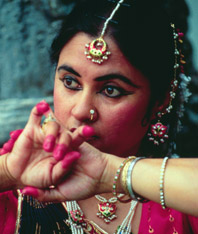Dance Review: The Hungry Stones” at the Southern
Natalie Harter reviews The Hungry Stones, a rich dance/drama by Katha Dance Theater, at the Southern Theater in Minneapolis.


Every Saturday morning at around 11:30 AM the floors of the Center for Performing Arts in Minneapolis begin to shake with an indescribable force. I discovered this interesting natural phenomenon while taking classes there last summer. I, and everyone else on the first floor, would look up at the ceiling and marvel at the occurrence. The astonishment only increased when the thunderous noise upstairs was linked to a handful of rather small and seemingly delicate women spotted ascending the stairs shortly beforehand. We then realized, while shaking dust out of our hair, that we were witnessing the awesome power of Katha Dance Theater.
Katha, the only Midwestern professional company of its kind, performs North Indian Kathak dance. This classical form is recognized for its strong percussive footwork, expressive gestures, and impossibly fast turns. The name Kathak derives from the Sanskrit word katha, meaning “story,” and Katha Dance Theater takes it upon itself with “The Hungry Stones” to honor the original purpose of the dance – that of telling a good tale.
The performance is based on the story by the same name written by Nobel Laureate Rabindranath Tagore in 1895. The tale revolves around a solitary tax collector in colonial India, sent on assignment to a small town known for its deserted palace. Against the warnings of his office clerk and the local madman, the collector (Donald La Course) decides to take up residence in the palace. Night after night he is tempted and tormented by the spirit of the place, which is so strong it brings the very stones to life. He neglects his work, sleep, and sanity to follow the elusive apparition of a woman (artistic director and choreographer Rita Mustaphi) with whom he has fallen truly madly in love.
The haunting atmosphere of the story and the palace it pivots on is beautifully evoked by the chorus of female dancing “stones.” These dancers, spanning four decades in age, advance the story in nearly twenty (or more, I lost count after fifteen or so) distinct pieces. They are at one moment playful and coquettish, grooming themselves and splashing in the river, and the next fiercely foreboding, guarding the palace from unwanted guests.
While the technical aspects of Kathak are always impressive, the most powerful moments in this performance feature the simplest choreography. In one bewitching piece, two dancers veiled in black hold a mirror frame while taking slow, purposeful steps backward toward the audience, separating LaCourse, peering into the mirror, from Mustaphi, peering out. Just as we become used to the footwork pattern and the dirge-like tempo of the drumbeat, the veiled dancers step to the side and the frame separates in two, allowing the lovers a brief moment of connection.
Mustaphi portrays the tempestuous and lovelorn spirit that is trapped in the walls of the palace. She feeds upon the desires of any man who steps (or at least sleeps) within her domain, in the hopes that he will release her from her marble prison. In the last piece danced on stage, the lovers are once again mediated by the stones, but the mood has switched from longing to disdain after Mustaphi realizes that LaCourse is too cowardly to set her free. The entire chorus of stones form a barrier with their bodies, each dancer holding a palm up to him, blocking him from entrance despite his pleas. Literally stone-faced, they stamp their feet like in time with the syllabic calls of Mustaphi like wind-up soldiers following the command of their general.
While the dance never disappoints, other attempts at storytelling are less successful. The multimedia exposition is rather disjointed and distracting; utilizing such varied approaches as direct address to the audience, dialogue between actors, and recorded voiceover translation of song lyrics. The performance sometimes suffers from a too literal interpretation of the text, as in the abrupt ending and the voiceover inclusion of a discussion at a train station that doesn’t quite make sense in a live setting. The acting by LaCourse is at times painfully melodramatic, which may be intentional, but simply seems too large for the intimate space of the Southern Theater.
Melding literature, dance, and drama is certainly no easy feat, and I would be less critical of the shortcomings in this performance if I didn’t know that the company was capable of pulling off such a fusion seamlessly, as they did in last year’s production of “Sister India,” which featured a nearly identical cast. Katha Dance Theater performed different versions of “The Hungry Stones” in 1994 and 1996, and it seems they are still working out how to best present the piece on stage. While the dramatic presentation may still be a work in progress, the choreography is consistently stunning, as are the dancers, who can apparently bring any building, real or imagined, to life.
Natalie Harter is a writer on dance and performance who lives and works in St. Paul.